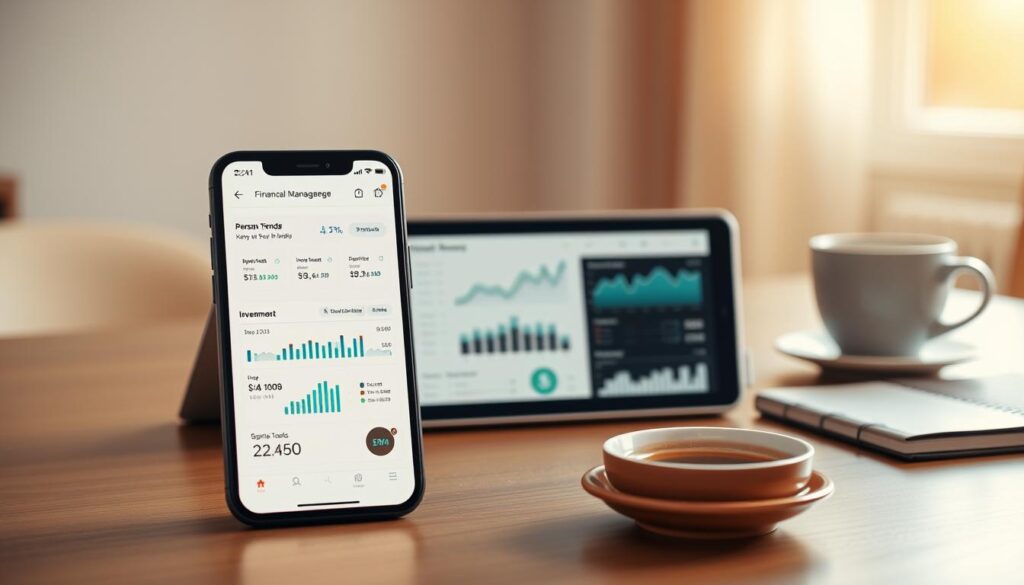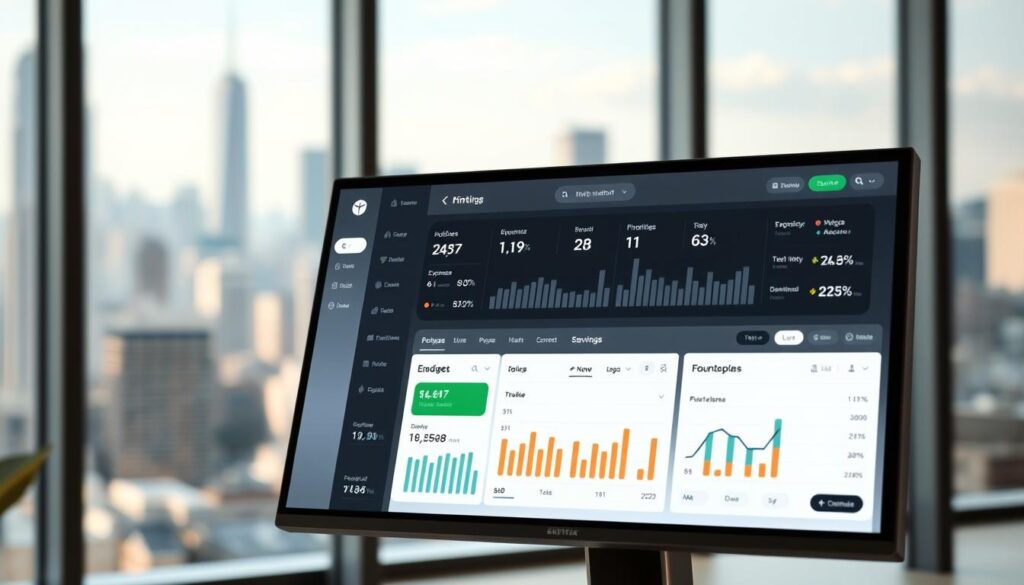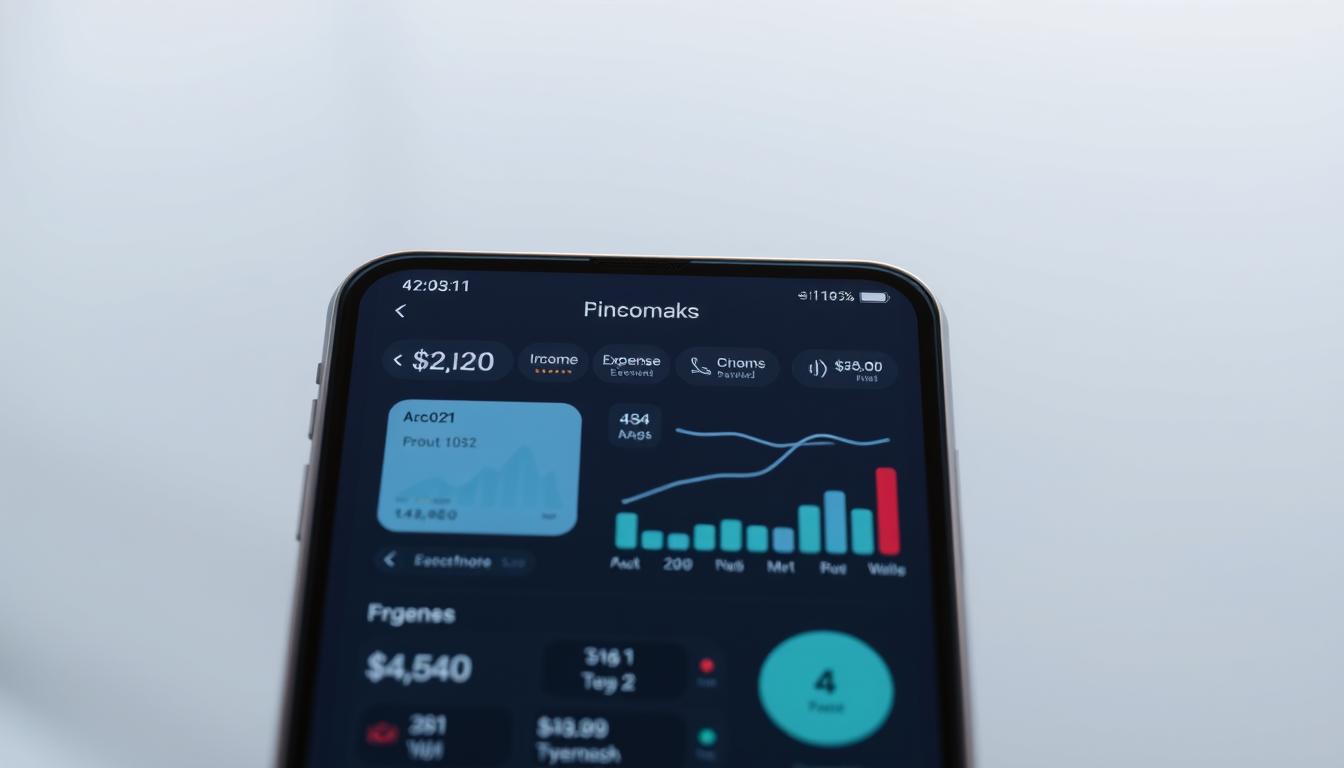Are you tired of living paycheck to paycheck? Do you struggle to keep track of your expenses and save for the future? You’re not alone. Managing your finances well is a big challenge, but the right tools can make it easier.
Efficient money management is key in today’s fast world. There are many budgeting and finance apps out there. They help you take charge of your financial health like never before. At FortyDeal, we’re here to help you make smart choices. For more info, visit our website at www.fortydeal.com or email us at [email protected].
Key Takeaways
- Discover the top budgeting and personal finance apps.
- Learn how to effectively manage your finances.
- Understand the benefits of using money management apps.
- Find out how to choose the best app for your financial needs.
- Get tips on maximizing your savings with the right tools.
The Financial Revolution in Your Pocket

Managing your money is changing fast thanks to digital tools. Now, with finance management tools and budget tracking apps, you can control your finances better.
How Digital Tools Are Changing Money Management
Digital tools are making a big difference in how we manage money. They offer real-time tracking, automated savings, and insights tailored just for you. You can check your spending anytime, sort your expenses, and get alerts if you spend too much. This was impossible with old methods.
Why App-Based Budgeting Outperforms Traditional Methods
App-based budgeting beats old ways because it’s simpler and more effective. Unlike manual budgeting, which takes a lot of time and can have mistakes, apps do it all for you. This makes it easier to reach your financial goals.
Here’s a comparison of traditional and app-based budgeting:
| Feature | Traditional Budgeting | App-Based Budgeting |
|---|---|---|
| Tracking Method | Manual entry | Automated tracking |
| Error Margin | High | Low |
| Time Efficiency | Time-consuming | Quick and efficient |
Using these digital tools can make your financial life more organized and less stressful. Their convenience and accuracy make them key for managing money today.
Understanding Budgeting & Personal Finance Apps

There are many financial apps out there, each with its own features. Budgeting and personal finance apps are key to managing your money well. They help with everything from tracking expenses to managing investments.
Expense Tracking Apps
Expense tracking apps help you keep an eye on your spending. Apps like Mint and PocketGuard link to your bank and credit cards. They automatically track your spending and help you find ways to save.
Budget Planning Apps
Budget planning apps go beyond tracking expenses. They help you set up a budget that meets your financial goals. Apps like YNAB (You Need A Budget) and EveryDollar let you organize your income. They also track your progress and help you make changes.
Investment and Wealth Management Apps
Investment and wealth management apps are for those who want to grow their money. Apps like Personal Capital and Robinhood track your investments and offer advice. They help you make smart investment choices.
Knowing about different budgeting and personal finance apps helps you find the right one for you. Whether you need to track expenses, plan your budget, or manage investments, there’s an app for that. They all aim to help you achieve financial stability.
Essential Features to Look for in Financial Apps
To get the most out of your financial app, you need to know what features to look for. A good app can help you manage your money better. It makes it easier to stick to your budget and reach your financial goals.
User Interface and Accessibility
A user-friendly interface is key for any financial app. It should be easy to use and navigate. Look for apps with clear menus and customizable dashboards.
Accessibility features like font size adjustment and voice commands can also improve your experience.
Security and Privacy Protections
Strong security measures are a must for financial apps. Make sure the app uses advanced encryption and two-factor authentication. It’s also important to check the app’s privacy policy and how it protects your data.
Bank Account Integration
Being able to link your bank accounts is a key feature. This lets you track your income and expenses in real-time. Look for apps that work with many banks and financial institutions.
Reporting and Analytics Capabilities
Good reporting and analytics are crucial for understanding your finances. A good app should give you detailed insights into your spending and savings. Customizable reports and visual analytics help you spot areas for improvement.
By focusing on these essential features, you can find a financial app that meets your needs. Whether you want to track expenses, create a budget, or manage investments, the right app can make a big difference.
Step-by-Step Guide to Choosing the Right App for Your Needs
Choosing the right financial app is not easy with so many options. You need to think about your financial goals and how easy the app is to use.
Assessing Your Financial Goals
First, understand what you want to achieve financially. Think about both short-term and long-term plans.
Short-term vs. Long-term Planning
Short-term goals might be saving for a trip or paying off a small debt. Long-term goals could be planning for retirement or buying a house.
Identifying Your Financial Pain Points
Next, find out where you struggle financially. This could be overspending or not saving enough.
Evaluating App Complexity vs. Your Tech Comfort
Think about how comfortable you are with technology. Some apps have advanced features that might be too much for beginners.
Free vs. Paid Apps: What’s Worth Paying For
Choose between a free or paid app. Free apps are useful, but paid apps often have more features.
| Feature | Free Apps | Paid Apps |
|---|---|---|
| Basic Budgeting | Yes | Yes |
| Advanced Analytics | No | Yes |
| Customer Support | Limited | Priority |
Top Expense Tracking Apps for Daily Spending
Managing daily expenses is key to good personal finance. The right expense tracking app can make a big difference. With so many options, it’s important to pick one that meets your financial needs and habits.
Mint: All-in-One Financial Tracking
Mint is a top expense tracker app for tracking finances. It lets users monitor spending, set budgets, and get bill reminders.
Key Features and Benefits
Mint has a user-friendly design, automatic expense grouping, and updates on transactions. Using Mint can help you keep track of money, avoid overspending, and save more.
Best Use Cases
Mint is great for those looking for a full financial management tool. It’s perfect for tracking spending across different accounts and getting personalized financial advice.
PocketGuard: Simplified Spending Control
PocketGuard is a popular money-saving app for managing daily expenses. It gives a clear view of your finances, helping you stay on budget.
Key Features and Benefits
PocketGuard’s « In My Pocket » feature shows how much you can spend. It also categorizes expenses automatically. Using PocketGuard can simplify spending, reduce financial stress, and improve budgeting.
Best Use Cases
PocketGuard is best for those who want a simple, easy-to-use expense tracker. It’s great for managing finances and avoiding overspending.
Clarity Money: AI-Powered Expense Management
Clarity Money is a budgeting & personal finance app that uses AI for expense management. It offers personalized financial advice and insights to improve your financial health.
Key Features and Benefits
Clarity Money tracks expenses with AI, gives personalized advice, and monitors subscriptions. It helps you understand your finances better, cut unnecessary spending, and save more.
Best Use Cases
Clarity Money is perfect for tech-savvy users who want advanced expense tracking. It’s ideal for those who want to understand their spending habits and get tailored financial advice.
Best Budgeting Apps for Financial Planning
Effective financial planning is key to reaching your long-term goals. The right budgeting app can make a big difference. With so many options, it’s important to pick one that fits your financial needs and goals.
YNAB (You Need A Budget): Zero-Based Budgeting
YNAB is a top choice for budgeting. It uses a zero-based budgeting method. This means every dollar has a job, helping you make the most of your money.
Key Features and Benefits
YNAB lets you track your expenses in real-time. This keeps you on top of your finances. It also has a goal-setting feature to help you reach your financial goals.
Best Use Cases
YNAB is great for those who want to manage their finances well. It’s perfect for people who spend too much or have many financial goals.
EveryDollar: Simplified Budget Creation
EveryDollar is known for making budgeting easy. It has a simple interface and a straightforward way to manage your money.
Key Features and Benefits
EveryDollar has easy-to-use tools and customizable categories. This makes creating a budget that fits your needs simple.
Best Use Cases
EveryDollar is good for beginners or those who like simple apps. It’s also great for quick and easy budget creation.
Goodbudget: Envelope Budgeting System
Goodbudget uses the envelope budgeting system. You allocate funds to different categories (or envelopes) to manage your expenses.
Key Features and Benefits
Goodbudget offers envelope budgeting for visual expense management. It also has collaboration features for sharing budgeting with a partner or family.
Best Use Cases
Goodbudget is perfect for those who like traditional budgeting or visual expense management. It’s also great for couples or families budgeting together.
When choosing a budgeting app, think about your financial goals, budgeting style, and preferences. The right app can help you control your finances and achieve long-term success.
| Budgeting App | Key Features | Best Use Cases |
|---|---|---|
| YNAB | Zero-based budgeting, real-time tracking | Proactive budgeting, financial goal-setting |
| EveryDollar | Simple budgeting, customizable categories | Easy budgeting, beginners |
| Goodbudget | Envelope budgeting, collaboration features | Visual budgeting, couples/families |
« The key to successful financial planning is to find a budgeting app that works for you and stick to it. »
Setting Up Your First Budget in 5 Easy Steps
Starting to manage your money is easy with a budgeting app. Just follow these simple steps to take charge of your finances. This way, you can make smart choices about your money.
Step 1: Download and Install Your Chosen App
First, download and install your favorite budget app from the app store. You might pick Mint, YNAB, or another top app. Make sure it fits your financial needs. Most money management apps are free, but some have premium features for a fee.
Step 2: Connect Your Financial Accounts Securely
Next, link your financial accounts to the app. This is key to tracking your money right. Good finance management tools keep your data safe with strong security.
Step 3: Categorize Your Income and Expenses
Sorting your money into categories helps you see where it goes. Most apps let you set up groups like housing, food, and fun. Make sure to track both your income and spending.
Step 4: Set Spending Limits and Savings Goals
Now, set limits and goals for your spending. This helps you stay on budget and reach your money goals. Many apps send alerts when you’re close to your limits, keeping you on track.
Step 5: Schedule Regular Reviews and Adjustments
Finally, plan to check your budget often. Your money situation can change, and so should your budget. Regular checks help you adjust and stay on course to meet your financial targets.
| Step | Description | Benefit |
|---|---|---|
| 1 | Download and Install App | Access to budgeting tools |
| 2 | Connect Financial Accounts | Accurate tracking of income and expenses |
| 3 | Categorize Income and Expenses | Clear understanding of spending habits |
| 4 | Set Spending Limits and Savings Goals | Sticking to budget and achieving financial goals |
| 5 | Schedule Regular Reviews | Adaptability to financial changes |
Common Mistakes to Avoid When Using Financial Apps
To get the most out of your personal finance software, it’s crucial to avoid common pitfalls. Many users unknowingly make mistakes that can hinder their financial progress. By being aware of these errors, you can maximize the benefits of budgeting and personal finance apps.
Ignoring Security Best Practices
One of the most critical mistakes is neglecting security best practices. Using weak passwords, not enabling two-factor authentication, and failing to update your apps regularly can expose your financial data to risks. Ensure you use strong, unique passwords and keep your financial apps updated.
Setting Unrealistic Budgeting Goals
Setting unrealistic budgeting goals can lead to frustration and abandonment of your financial plans. Be realistic when setting budgets; consider your income, expenses, and financial goals. Start with small, achievable targets and gradually adjust as needed.
Failing to Reconcile Automated Entries
Automated tracking is a convenience offered by many financial apps, but it’s essential to regularly reconcile these entries. Failing to do so can result in unnoticed errors or discrepancies. Schedule regular checks to ensure your app’s records match your actual financial situation.
Overlooking Subscription Fees and Hidden Costs
Many financial apps come with subscription fees or hidden costs. Be aware of these charges and factor them into your budget. Some apps may offer free versions or trials, but understanding the full cost is crucial to avoid unexpected expenses.
To illustrate the potential impact of these mistakes, consider the following comparison:
| Mistake | Potential Impact | Prevention Strategy |
|---|---|---|
| Ignoring Security Best Practices | Financial data exposure | Use strong passwords, enable 2FA |
| Setting Unrealistic Budgeting Goals | Frustration, abandonment | Set realistic, achievable targets |
| Failing to Reconcile Automated Entries | Unnoticed errors, discrepancies | Regularly review and reconcile |
| Overlooking Subscription Fees and Hidden Costs | Unexpected expenses | Understand full costs, factor into budget |
By being mindful of these common mistakes and taking steps to avoid them, you can effectively use budgeting and personal finance apps to achieve your financial goals. Stay vigilant, and make the most of your money-saving apps.
Transforming Your Financial Future with Digital Money Management
Using a financial planning app can change your financial future. These digital tools help you make smart money choices. They guide you towards reaching your financial goals.
A budget tracking app is more than a tool; it’s a financial partner. It lets you watch your spending and find ways to save. It also helps you stay on track with your budget goals. With a money management app, managing your finances becomes easier, from tracking bills to watching investments.
The right digital money management tools can make your financial life simpler. By picking an app that meets your needs, you can achieve financial stability and security. Whether saving for a goal or managing daily expenses, the right app can lead to financial freedom.
Now that you know how to pick the best app, it’s time to act. Choose an app that matches your financial goals. Start changing your financial future today.
FAQ
What are the benefits of using a budgeting and personal finance app?
A budgeting app helps you track your spending and make a budget. It shows you your financial situation clearly. This way, you can make smart money choices.
How do I choose the right financial app for my needs?
First, think about your financial goals and what features you need. Look at how easy the app is to use. Read reviews and check for security and privacy.
Are budgeting and personal finance apps secure?
Yes, most apps are secure with encryption and other safety measures. Always check an app’s security and read reviews before using it.
Can I use a budgeting app if I’m not tech-savvy?
Yes, many apps are easy to use, even for those not tech-savvy. Look for apps with simple interfaces and good customer support.
How do expense tracking apps work?
Expense tracking apps connect to your bank and credit cards. They sort your spending into categories. This gives you a clear view of your spending habits.
What is the difference between a free and paid budgeting app?
Free apps have basic features. Paid apps offer more, like investment tracking and bill reminders. Think about what you need and your budget.
Can I use a budgeting app to track my investments?
Yes, some apps let you track your investments. This helps you monitor and manage your financial portfolio.
How often should I review my budget?
Review your budget weekly or monthly to stay on track. Use your app for regular check-ins to keep your finances in order.

